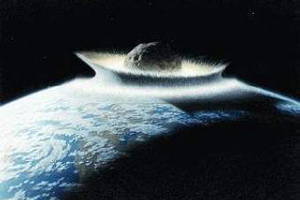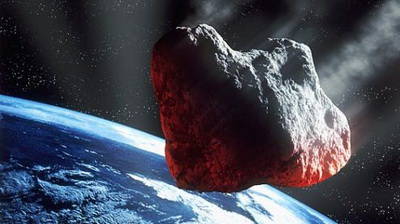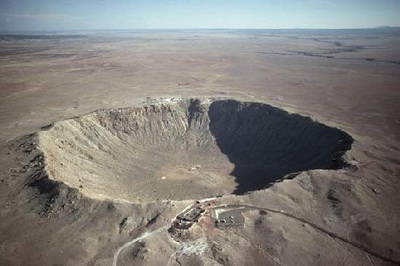Asteroid threat

Asteroids have always represented a danger to the Earth - just look at the example of the disappearance of dinosaurs, but since then more than 60 million years have passed. For all the time of its existence, mankind has not faced such a problem, and, to be honest, only the 20 century began to think about it, when modern powerful telescopes fell into the hands of astronomers. This topic was also addressed by the Ren-TV “Military Secret” channel, in which the announcer told the audience in a cheerful voice that 4 in May 2062, the Earth will face a global catastrophe caused by the fall of the asteroid VD17. The scale of the catastrophe and its probability are clearly exaggerated, but the likelihood that humanity can repeat the fate of dinosaurs really exists.
Currently, the number of potentially dangerous asteroids is estimated at 10 - 20 thousand. But they do not pose a mortal danger to humanity. Research by David Rabinovich and his colleagues at Yale University in the USA suggests that the estimate of large near-Earth asteroids was greatly overestimated at least twice. If earlier scientists talked about almost 2000 objects with a diameter of more than 1 km., Now their number has decreased to 500-1000 pieces. This estimate of the number of celestial bodies was obtained using the NEAT asteroid tracking system mounted on the Hawaii telescope on the top of Mount Haleakala. Currently, almost all the asteroids of this weight category are defined, the same applies to asteroids about 10 km in diameter that can destroy life on the planet. According to a number of scientists, it was the collision of the Earth with a celestial body about 10 km in diameter that led to the extinction of dinosaurs and approximately 70% of the flora and fauna of the planet.
Today, science knows two of the most dangerous asteroids, Apophis and VD17. Both asteroids were discovered in 2004 year. Apophis is an asteroid with a diameter of 320 meters and a weight of almost 100 million tons. The probability that a given celestial body will collide with the ground of 13 on April 2036 of the year is estimated as 1: 5000. Until recently, this asteroid on the Turin Asteroid Hazard Scale was in the lead, however, the observation of the VD475 celestial body during the 17 days led it to the lead. This asteroid with a diameter of 580 meters and a weight under 1 of a billion tons has the largest known probability of collision with the Earth today. His chances of colliding with our planet in 2102 are estimated as 1: 1000.

An asteroid as large as VD17 would collide with the Earth to form a crater with a diameter of 10 km and trigger an earthquake with a Richter scale 7,4 scale on the basis of the order of 10 thousand megatons of energy, which is comparable to the entire Earth’s arsenal of nuclear weapons). Fortunately, we, and even the next generation more precisely, have a century to take any action in this regard.
If we talk about the Turin scale, then both of these celestial bodies - Apophis and VD17 - have a very small value on the scale of danger - 1 and 2 points, respectively. To demonstrate what this means, we give the scale itself below.
Turin scale asteroid hazard
Events without consequences
0 - the probability of a collision of the Earth with a space body is equal to 0 or lower than the probability of a collision of the Earth with a celestial body unknown to science of comparable size over the coming decades. The same assessment is received by celestial bodies that simply burn in the atmosphere of the Earth.
Events that deserve careful checking
1 - the probability of collision with the Earth is extremely low or equal to the probability of a planet colliding with an unknown celestial object of the same size.
The attention of astronomers, events that deserve concern
2 - the celestial body will approach the Earth, but the collision will be unlikely.
3 is a fairly close approach to the planet with a probability of collision from 1% and higher. A collision threatens the planet with local destruction.
4 is a fairly close approach to the planet with a probability of collision from 1% and higher. Collision with the Earth threatens with regional destructions.
Earth threatening events
5 is a fairly close approach to the planet with a serious likelihood of collision, which can be accompanied by regional destruction.
6 is a fairly close approach to the planet with a serious likelihood of a collision that could trigger a global catastrophe.
7. - a fairly close approach to a planet with a very high probability of collision may cause a global catastrophe.
Inevitable clashes
8 - Earth's collision with a celestial body causing local destruction (similar events occur every 1000 years)
9 - the collision of the Earth with a celestial body, which will cause global destruction on the planet (similar events occur every 1000-100 000 years)
10 - the collision of the Earth with a celestial body, which will lead to a global catastrophe (such events are recorded once in 100 000 years or more).
Despite such a low probability of collision with two well-known asteroids in science, we should not discount other smaller ones with a diameter from 100 to 300 meters. The fall of such a heavenly gift to Earth could result in the loss of some major city. And in this matter, the first place is the speed of detection of such celestial bodies. It is very important not to “sleep through a catastrophe”.

So, the asteroid DD45 was detected by 28 in February of 2009, and after three days it was dangerously close to Earth. The asteroid AL30 three hours after its detection flew at an altitude of 130 000 km., That is, below the orbit of artificial earth satellites. There were cases when astronomers discovered a dangerous object after danger. So, 23 March 1989, astronomers discovered 300-meter asteroid Asclepius, who crossed the orbit of our planet at the point where the Earth was only 6 hours ago. The asteroid was discovered after it flew off from the Earth. Therefore, the main danger is not that an asteroid measuring 300 meters and more will collide with the Earth, it is rather small, but that it will be discovered too late.
They work on solving this problem not only in the USA, but also in our country. The process of countering the asteroid threat includes three components: 1) regular search for new asteroids and monitoring of objects already known to scientists that are dangerous to the planet; 2) designing tools for observing and actively countering asteroids; 3) develop accurate and reliable countermeasures.
Vladimir Degtyar, Corresponding Member of the Russian Academy of Sciences, believes that at the 2 and 3 stages it would be possible to use the Kapkan universal spacecraft, which can either change the orbit of a celestial body or destroy it. characteristics of the asteroid to use the spacecraft reconnaissance "Kaissa". The development of these devices in our country is underway.
The self-guided, high-precision impact spacecraft “Kapkan” consists of a homing head, engine, orientation and stabilization equipment. It can be equipped with one shock or a variable number of shock modules that can be detached from the apparatus, each of which has its own propulsion system. After the discovery of an asteroid approaching the Earth, the “Trap” enters a predetermined trajectory. The on-board facilities of the device establish the parameters of the motion of the celestial body and make adjustments to the flight path of the ship. Later the shock blocks are separated, the ship’s equipment records the effects of a strike on a celestial body and transmits them to Earth.
The main problem is how to make the “Trap” in the right place at the right time, because the smaller the size of the asteroid, the greater the requirements for its detection range and interception rate. Prelaunch preparation should take less than two days. The task of how to deliver the “Trap” to the asteroid is planned to be solved with the help of promising carrier rockets: to asteroids with a diameter of 600-700 meters - with the help of the Russia-M rocket, to asteroids with a diameter up to 300 meters - with the help of the Soyuz-2 rocket ".
According to the estimates of the specialists of JSC “GRTS Makeeva”, the sum of expenses for the creation of the necessary spacecraft and their adaptation to the rocket-space complexes will cost approximately 17 billion rubles. and will take about 10 years. The money is quite large, but not comparable with the possible costs of repairing the infrastructure damaged by some random asteroid.
Sources used:
www.nationalsafety.ru/n44319
www.grani.ru/Society/Science/m.102596.html
www.galspace.spb.ru/index65-3.html
Information